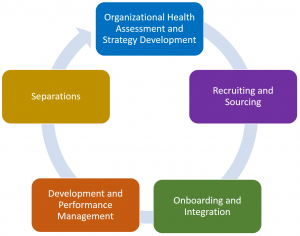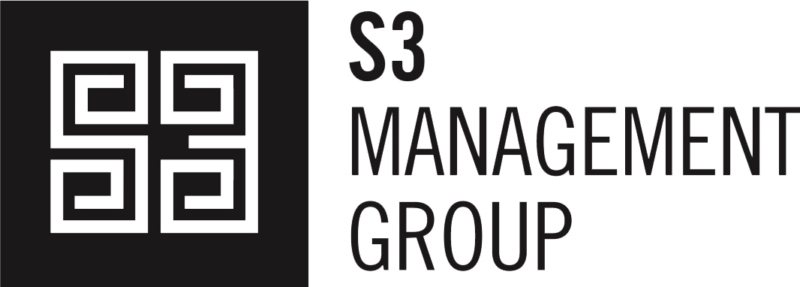If you are responsible for managing people, you are more than likely familiar with the concept of the Employee Lifecycle; if you are responsible for managing costs, you may also be familiar with the concept of Risk Management. Rarely, however, do organizational leaders integrate the concepts of the Employee Lifecycle and Risk Management into a management practice for their business. And the real costs to an organization for this lack of integration are substantial.
Employee Lifecycle and Risk Management (ELRM)
is the process of managing an organization so that the employees are functioning in a way that positively contributes to your bottom line. For tribes and tribal-owned businesses, the stakes are even greater. ELRM extends beyond the positive ROI it generates and provides an opportunity for stewardship. It’s about taking care of people, your employees, in such a way that it ultimately takes care of your people. When you steward and manage your employee lifecycle with excellence, the positive return generated flows not only to you, but to your tribe and tribal members.
What is the Employee Lifecycle?
Understanding the integrated employee lifecycle and risk management process is an important part of making sure your organization is optimized to improve employee engagement, performance, and retention while minimizing unnecessary costs. For most businesses the optimal ELRM model includes:
- Organizational Health Assessment and Strategy Development
- Recruiting and Sourcing
- Onboarding and Integration
- Development and Performance Management
- Separations
The Importance of an Organizational Health Assessment
Before you can begin to make improvements in the employee life cycle and minimize unnecessary lifecycle costs at your company, it’s important to know how things stand right now. An organizational health assessment allows you to do exactly that.
With this assessment, you can see how your organization currently performs and find gaps that need to be addressed. An organizational assessment looks at areas such as:
- Foundation: your mission, values, and vision statements
- Function: your plans, policies, and procedures
- Management: strong leadership direction, organizational structure, and employee satisfaction
- Human Resources: employee handbook, performance appraisal system, and the employee life cycle
For an effective ELRM process to be implemented, organizational health assessments must be performed on a regular basis, and organizations must continuously implement changes based on what they learn from these assessments. These regular “tune-ups” are a key part of any risk management cycle. They help you identify your strengths and weaknesses, your differentiators and your unnecessary cost drivers. They will not only provide improvements in the operations of an organization, but they will also help to establish a culture where employees move towards excellence and remain committed to the current and future success of the organization.
Recruitment
The first step in the employee life cycle is when a new team member is recruited to work at your company. At this stage, Human Resources helps your company find the right person for the open position. This includes writing a clear job description, placing recruitment ads, reviewing resumes, and performing interviews.
This stage of the employee lifecycle has three vital elements: first, accessing a broad population of eligible and qualified candidates; second, ensuring that potential candidates are a great fit for your company culture and have the skills and talents needed. Third, it’s important to ensure that your company is the right fit for the new team member’s goals, abilities, and personality.
Onboarding and Integration
Once a new team member has been selected, they experience your onboarding and integration process. This begins on their first day and continues until they are fully trained in their job and fully integrated into the company structure. Many times this includes training, mentoring, and formal introductions to key leaders.
The importance of onboarding and integration is often underestimated. The saying, “You never get a second chance to make a first impression,” applies well here. How you train, mentor, and incorporate a new employee into company life will affect the rest of their tenure with you. You want to ensure that the employee starts off motivated, comfortable, and feeling like part of the team.
Development and Performance Management
As a new employee continues their career, they will develop new skills, receive performance appraisals, and perhaps be promoted into new positions. Career development and training is an important part of making sure that employees remain engaged with your company – and unfortunately, it’s often neglected.
If career development and performance management are poorly handled, you’ll see high turnover and low employee satisfaction. You’ll also see low efficiency and poor performance. All of these things cost your company in terms of money and growth. It’s vital that an organization have a plan and follow through to make sure all team members have the development and leadership they need.
Employee Separations
Employers are generally comfortable with the practice of hiring and managing their people, but unfortunately, they often neglect the importance of effectively managing employee separations. Establishing solid separation practices throughout an organization, however, pays large dividends. An organization that maintains solid separation practices creates a culture of trust and job satisfaction for existing employees, and it also minimizes unnecessary costs associated with lawsuits and unemployment.
Employee Lifecycle and Risk Management for Tribal-Owned Businesses
At S3 Management Group, our employee lifecycle and risk management approach is optimized specifically for tribal employers – embracing the unique tribal laws and cultural challenges associated with sovereign tribal governments and tribal-owned businesses. This is represented in our core values and found in the services we provide, the training we offer, the programs we develop, and the tools we provide. No other ELRM provider in Indian Country has this focus or expertise.
Employee Lifecycle and Risk Management has a significant impact on your company. Doing it poorly can hinder growth and cause you to incur huge expense. But, doing it well returns a strong benefit to a tribe and its people. From reputation in the community to increased profitability that funds additional tribal programs, the right ELRM practices will set your business apart. To find out how we can help your company, contact us today!

